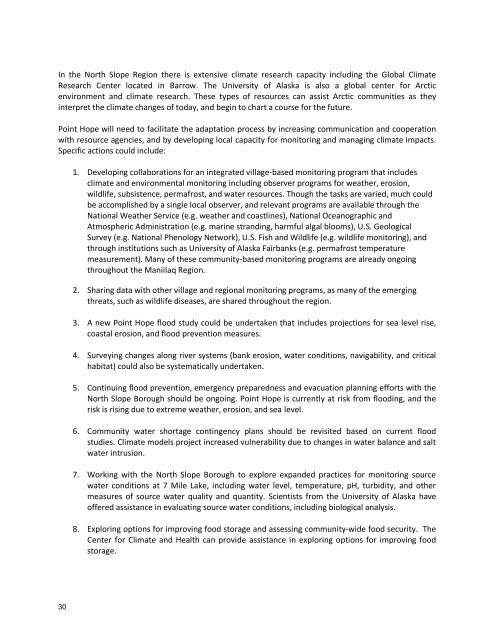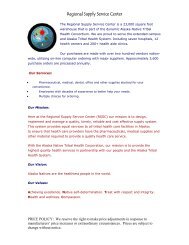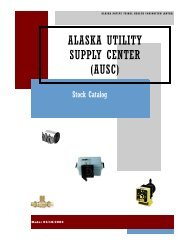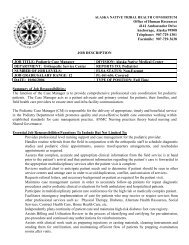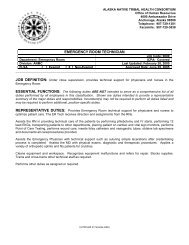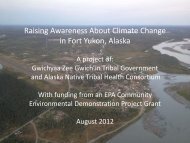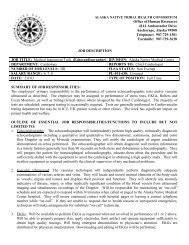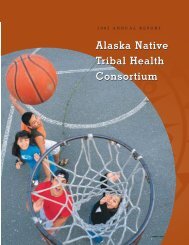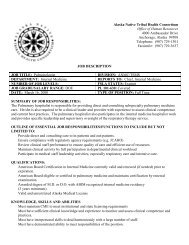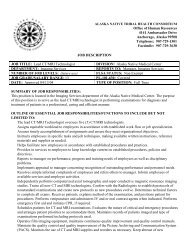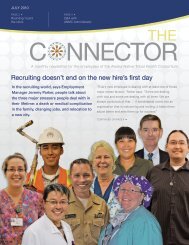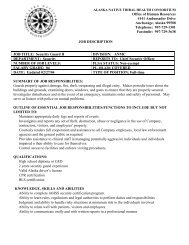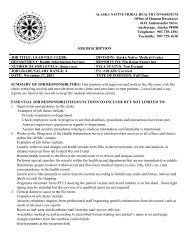Draft Final Climate Change and Health Impacts Point ... - ANTHC
Draft Final Climate Change and Health Impacts Point ... - ANTHC
Draft Final Climate Change and Health Impacts Point ... - ANTHC
Create successful ePaper yourself
Turn your PDF publications into a flip-book with our unique Google optimized e-Paper software.
In the North Slope Region there is extensive climate research capacity including the Global <strong>Climate</strong><br />
Research Center located in Barrow. The University of Alaska is also a global center for Arctic<br />
environment <strong>and</strong> climate research. These types of resources can assist Arctic communities as they<br />
interpret the climate changes of today, <strong>and</strong> begin to chart a course for the future.<br />
<strong>Point</strong> Hope will need to facilitate the adaptation process by increasing communication <strong>and</strong> cooperation<br />
with resource agencies, <strong>and</strong> by developing local capacity for monitoring <strong>and</strong> managing climate impacts.<br />
Specific actions could include:<br />
1. Developing collaborations for an integrated village‐based monitoring program that includes<br />
climate <strong>and</strong> environmental monitoring including observer programs for weather, erosion,<br />
wildlife, subsistence, permafrost, <strong>and</strong> water resources. Though the tasks are varied, much could<br />
be accomplished by a single local observer, <strong>and</strong> relevant programs are available through the<br />
National Weather Service (e.g. weather <strong>and</strong> coastlines), National Oceanographic <strong>and</strong><br />
Atmospheric Administration (e.g. marine str<strong>and</strong>ing, harmful algal blooms), U.S. Geological<br />
Survey (e.g. National Phenology Network), U.S. Fish <strong>and</strong> Wildlife (e.g. wildlife monitoring), <strong>and</strong><br />
through institutions such as University of Alaska Fairbanks (e.g. permafrost temperature<br />
measurement). Many of these community‐based monitoring programs are already ongoing<br />
throughout the Maniilaq Region.<br />
2. Sharing data with other village <strong>and</strong> regional monitoring programs, as many of the emerging<br />
threats, such as wildlife diseases, are shared throughout the region.<br />
3. A new <strong>Point</strong> Hope flood study could be undertaken that includes projections for sea level rise,<br />
coastal erosion, <strong>and</strong> flood prevention measures.<br />
4. Surveying changes along river systems (bank erosion, water conditions, navigability, <strong>and</strong> critical<br />
habitat) could also be systematically undertaken.<br />
5. Continuing flood prevention, emergency preparedness <strong>and</strong> evacuation planning efforts with the<br />
North Slope Borough should be ongoing. <strong>Point</strong> Hope is currently at risk from flooding, <strong>and</strong> the<br />
risk is rising due to extreme weather, erosion, <strong>and</strong> sea level.<br />
6. Community water shortage contingency plans should be revisited based on current flood<br />
studies. <strong>Climate</strong> models project increased vulnerability due to changes in water balance <strong>and</strong> salt<br />
water intrusion.<br />
7. Working with the North Slope Borough to explore exp<strong>and</strong>ed practices for monitoring source<br />
water conditions at 7 Mile Lake, including water level, temperature, pH, turbidity, <strong>and</strong> other<br />
measures of source water quality <strong>and</strong> quantity. Scientists from the University of Alaska have<br />
offered assistance in evaluating source water conditions, including biological analysis.<br />
8. Exploring options for improving food storage <strong>and</strong> assessing community‐wide food security. The<br />
Center for <strong>Climate</strong> <strong>and</strong> <strong>Health</strong> can provide assistance in exploring options for improving food<br />
storage.<br />
30


